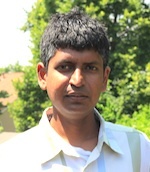An award from the National Science Foundation (NSF) will help a University of Iowa researcher to investigate the reliability of the U.S. electric grid, given the growth of wind turbines and other new energy sources.

Raghuraman Mudumbai, assistant professor of electrical and computer engineering in the UI College of Engineering, has been selected by the NSF to receive a 2012 Faculty Early Career Development (CAREER) Award. As an award recipient, he will receive about $400,000 over the next five years to study the U.S. electric grid.
Mudumbai says that renewable energy generators powered by wind, solar, or similar means differ in several key ways from conventional coal- or oil-based generators. They are intermittent, cannot be accurately forecast, and are not dispatchable—that is, they cannot be turned on at the request of a power grid operator.
His research will develop statistical methods to investigate the fundamental limits of grid reliability because of inherent generation uncertainty, with the ultimate aim of developing an "information theory" of the smart electric grid.
Furthermore, his research will develop optimal control algorithms, or mathematical formulas, for voltage and frequency regulation and economic dispatch, taking into account virtual and real energy storage capabilities and active management of renewable generators.
Says Mudumbai: “My control algorithms will be developed from a 'first principles' basis, from scratch rather than simply tweaking existing control procedures, and will be designed to be implemented in a distributed way to the extent possible to minimize the need for an excessively expensive communication infrastructure supporting the grid.”
He received his CAREER Award for the project titled “A ‘First-Principles’ Approach to Smart Electric Grid: Fundamental Limits and Optimal Control Algorithms.”
The CAREER award is the most prestigious NSF honor for junior faculty and recognizes research and teaching excellence, as well as scholars who are likely to become future academic leaders. The awards, presented to engineers and scientists across the country, are designed to help universities attract and retain outstanding young faculty members.
A recent UI CAREER Award winner, Albert Erives, associate professor of biology in the College of Liberal Arts and Sciences, is using his 2010 selection as a CAREER winner of $625,000 over five years to study how various cells in animal embryos develop in distinctly different ways.
The differentiation of distinct cell types in developing animal embryos is typically driven by concentration gradients of morphogens—substances that cause cells to do different things, according to the exact concentration of the morphogen. When a morphogen concentration gradient exists across a field of cells, an individual cell can "read-out" its position in the gradient and differentiate appropriately.
“My research is focused on understanding how DNA sequences at different genes respond to specific concentration-threshold levels of a morphogen that patterns the Drosophila embryo, a model developmental system,” Erives says. “This research is central to understanding how animal embryos are patterned and how genes underlying basic cellular processes are controlled at a molecular level.”
He received his CAREER Award for the project titled “Threshold-Specific Readouts of the Dorsal Morphogen Gradient of Drosophila.”
Another recent CAREER winner, David Cwiertny, received his CAREER Award in 2010 while on the faculty of the University of California, Riverside. Cwiertny, who came to the UI in 2011 as an assistant professor of civil and environmental engineering as well as an IIHR researcher, is receiving about $350,000 over five years.
His project aims to use engineered nanomaterials, specifically carbon nanotubes (CNTs), for water and wastewater treatment. In combination with ozone, a chemical oxidant commonly used for disinfection, CNTs can be used as reactive substrates to catalyze the destruction of a variety of pollutants in water supplies.
Cwiertny is well aware of the increasing need worldwide for clean water.
“Ultimately, technologies developed from this work may one day help move society toward more reliable, safe, and sustainable water supplies amid rising stressors on our natural water resources including population growth and climate change,” he says.
Cwiertny received his CAREER Award for the project titled “Hybrid Nanostructures as Catalysts for Advanced Oxidation Processes: An Integrated Research and Education Plan Promoting Water ReUse and Sustainability.”